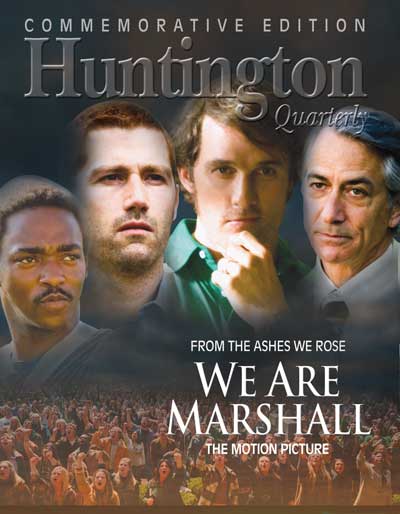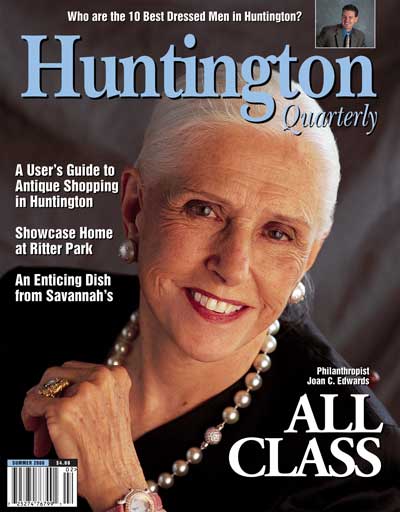As HQ begins its 20th year, we look back at the evolution of the city magazine that many said wouldn’t last a year.
By Carter Seaton
HQ 66 | Autumn 2008
According to one of the nation’s leading magazine experts, 60 percent of new publications fail in the first year; 80 percent fail by their fourth and 90 percent never celebrate their tenth anniversary. Similarly, when Huntington Quarterly premiered in 1989, skeptics said the slick magazine wouldn’t last a year, and then they said certainly not five. Now that HQ is entering its 20th year, clearly it has defied the statistics, the naysayers and a business maxim that says, “Attaining success is one thing – maintaining it is quite another.”
While Jack Houvouras, Publisher and Editor of Huntington Quarterly, had never heard that quote, he takes only partial credit for the success and longevity of his publishing company’s crown jewel.
“The people of Huntington have supported us through subscriptions but more importantly through advertising,” he says modestly.
When pressed for the keys to his success, he admits, however, that his commitment to excellence is certainly a factor.
“I didn’t set out to make money right away. I kind of had a long-term vision that I wanted to put out a quality product and that if I did, good things would come. I didn’t know quite how, but I at least wanted to have my name associated with something that was of the best quality possible,” Houvouras says. Secondly he credits his staff, giving high praise to his photographers, David Fattaleh and Rick Lee, the graphic designers and freelance writers, many of whom are products of Marshall’s journalism school, as is Houvouras himself.

Fellow publisher Marshall G. Reynolds, Chairman and CEO of Champion Industries, agrees that the quality of the magazine is a significant factor in Jack’s recipe for success, but he credits the force behind the magazine as well. “A bigger contributor may be Jack’s tenacity and his flexibility, as well. I think he is one of these guys who would make it whatever he did.”
Perhaps his reason for starting the magazine is what personifies its success most clearly, however. Simply said, he wanted to give the residents a reason to be proud of living here. “Huntington used to have an inferiority complex. I wanted to show people that although we’ve got our problems, we’ve also got a lot of positives.”
Circuit Judge Dan O’Hanlon echoes that sentiment. “Twenty years ago, Huntington was having an identity crisis. I really think we’ve turned the corner – we are certainly not there – but we’ve certainly turned the corner in terms of knowing who we are and who we are not, who we’ll never be and who we’ll always be. I really believe that the Huntington Quarterly has been critical in helping us have a central focus by telling us who we are.”
The dream that started with a love of the written word, a desk taken from his bedroom, money borrowed from his father to buy a used Macintosh computer with a nine-inch screen and a small office at his brother’s business, has become a success story Warren Buffet probably would applaud. Three months later Huntington Quarterly moved into a 75 square foot office on the third floor of the old Chamber of Commerce Building at 522 Ninth Street, where it remained until relocating to the Ratcliff Building in 1999.

From the beginning, each issue profiled Huntington’s leading citizens like A. Michael Perry, Marshall G. Reynolds, Joan C. Edwards, or William C. Campbell and prominent former residents who have made a name for themselves on the national or international stage, including businesswoman Verna Gibson, the late John Deaver Drinko or Alex Schoenbaum, founder of Shoney’s restaurants. It has showcased the city’s unique restaurants, outstanding homes and classic architecture, recalled its past, featured West Virginia travel destinations and, until the company began publishing Marshall Magazine in 1999, included a section on “The University.” The homes feature has consistently been the magazine’s most popular section showcasing the beauty of over 50 unique Huntington homes. These features make HQ a great marketing tool for the Huntington Regional Chamber of Commerce, according to its President and CEO, Mark Bugher, who calls it a really slick, glossy publication that he often gives to out-of-town visitors.
It also provides bragging rights for the many former residents who sometimes take heat for being from Huntington or West Virginia. They can open the latest copy of Huntington Quarterly and say, “Take a look at this.” They flip through it and watch their friends go, “Wow! This is a really nice city magazine. It’s nicer than our city magazine.” That’s one of the biggest thrills, Houvouras says. “Over the years, I’ve found that the people who are really the most loyal and who love the magazine the most don’t live in Huntington. So that shows you, I think, that the people of Huntington don’t realize what a nice, charming community they live in. They perhaps take it for granted. Until you’ve lived somewhere else for a while and seen their problems you don’t appreciate our lack of problems. But to give the people of Huntington a first-class magazine that some people say is better than some of the big city magazines they get where they live now – that’s very gratifying.”
The “Yesterday” feature is also popular, connecting readers to Huntington’s past. Margaret Mary Layne, Executive Director of the Huntington Museum of Art, says this is a great service to those who have moved here. “Think of all the people who have moved here because of the medical school and our health care industry,” she says. “They don’t know anything about the history of Huntington, but reading a magazine like this makes them feel more knowledgeable and thus more included in the community.”
Imagine moving here and discovering, through the pages of HQ, that Senator John F. Kennedy ate at Jim’s Steak & Spaghetti House during his presidential campaign, that Paul Newman visited the area in 1996 to absorb an Appalachian accent for Cool Hand Luke, that famed test pilot Chuck Yeager hails from our area, that one of Broadway’s most popular singers is Huntington native Mark McVey, or that comic Soupy Sales grew up in Huntington.
Some of the most popular issues were the 100 and 125 Great Things About Huntington. One of the most controversial issues contained a “Best Dressed Huntingtonians” story. Houvouras says the men didn’t care who made the cut, but since women debated his choices for some weeks, he won’t repeat it. Although his magazine isn’t about hard news, he does try to cover what’s newsworthy – Pullman Square’s opening, the rise of Marshall football or other changes at the university, the boom in health care, or Allegiant Air’s arrival in Huntington.

But by far the most popular, if not the most profitable issue, was the “We Are Marshall” special edition. As Jack recalls, “I was so excited about the movie that I wasn’t thinking about the bottom line. I only printed 5,000 copies of the special edition, which is what I print every issue. It was 144 pages and we had a slight increase in advertising revenue because people wanted to be in there. Our normal magazine size is only 80 pages.” When it sold out in three days he quickly ordered 5,000 more. After those sold out in three days as well, Houvouras ordered 15,000 more. Unfortunately, sales had slowed down because the holiday season was over. “Now I’ve got 8,000 magazines sitting in a warehouse,” he laughs. “I think I’m a pretty good businessman, but I obviously don’t know retail.”
As the publishing company enters its 20th year, it is in a new home in the re-developed East Hills Professional Center – a move precipitated by the fire that destroyed Ratcliff Place in downtown Huntington where the company had its offices. Despite the terrible loss, Houvouras says, “it didn’t really devastate me – at least not at first.” He had to get his business back up and running, which he did by the following week. It was only as time went on that he realized the magnitude of his loss – a letter to him from Chuck Yeager that called his profile “the best magazine article ever written about me,” an autographed photo of Randy Moss, color slides that can’t be replaced, original oil paintings by Marshall artists, and pieces of glass from now defunct Pilgrim Glass. He also lost 17 years of back issues, which prevents him from being able to fulfill special requests for old issues. Still, he says he had to “forge ahead and not think about what we’d lost.”
Jack’s dream that “good things would come” if Huntington Quarterly was a high quality product has come true. “It’s wonderful to be a part of a creative, collaborative effort and see it all come together. It’s not always perfect but we try to be as perfect as we can,” he says. With the addition of the Marshall Magazine in 1999 and St. Mary’s Today in 2002, the publishing company now puts out nearly one magazine a month and has been financially successful by branching out into these and other specialty publications. “If I can get more custom publishing work and make a little more money at that, I’ll probably put even more money back into HQ,” he says. Although the basic formula would remain the same, Houvouras says there’s always room for improvement, perhaps to add more stories or improve the paper quality.

If he’s met his original goal as he said in an interview at year 15, what’s next? Jack muses, “Well, I don’t want to be the next Rupert Murdoch, but I’d like to be successful and be able to give back more to the community and expand the horizons, with new goals and challenges. I always want to grow. I would like to expand the staff so we are not so stressed out about deadlines. I still find it exciting and fulfilling. There’s something different every issue; it’s not like you are doing the same thing every time. Each time that issue comes out, it’s very rewarding when it comes from the printer. You open it up, and flip through it. You see all your hard work and hopefully you don’t find any mistakes. You get to meet a lot of interesting people. It doesn’t hurt when you are walking down the sidewalk in Huntington to have people stop and say, ‘I loved your last issue.’ That’s what it’s all about, that’s what makes me proud.”
High Praise
“When people are in the office, I’ll often pick up an old copy of the magazine that we might have and give it to them. It’s really the most quality piece we have around here about Huntington. There are other good pieces, but it always has great stories in it and things you aren’t going to find out about just by looking at a website or picking up a newspaper.”
– Mark Bugher, President and CEO of the Huntington Regional Chamber of Commerce
“I really believe that the Huntington Quarterly has been critical in helping us have a central focus in telling us who we are, because it makes us look inward. When we get that issue four times a year, you read about the history of the place, you read about great architectural buildings here, you read about prominent citizens – past and present – and it gives that focal point for a community to help develop an identity.”
– Dan O’Hanlon, Circuit Judge in the 6th Judicial Circuit here in Cabell County
“I have old Huntington friends who live in the Carolinas or in Florida and I think Jack’s magazine is a historical link to the community and they at least get a booster shot every quarter about what’s going on back here. I believe that with each passing year, the publication makes a greater contribution to the area.”
– Marshall Reynolds, Chairman and CEO of Champion Industries
“I first received HQ when I still lived in Columbus and it made a very large impact on me. I thought, ‘Wow! Our city, one of the places I love in my life, is really going somewhere.’ I think the amazing articles and recognitions of accomplishments of exceptional individuals through the years have been just terrific. Huntington Quarterly has represented well our unique nature and the phenomenal individuals that live here.”
– Verna Gibson, Businesswoman and Vice Chair of Marshall University’s Board of Governors





